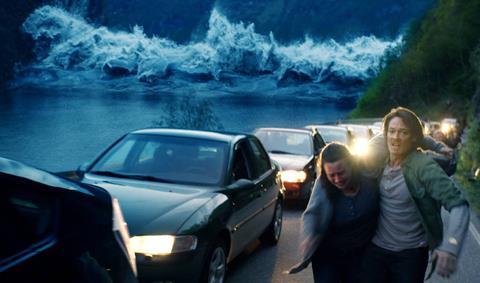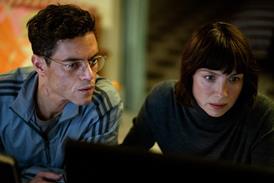Director Roar Uthaug’s fourth feature The Wave (Bolgen) has the proud distinction of being Scandinavia’s first disaster movie.

And what a disaster it is: the story follows what happens when a mountain rockslide causes an 80-metre tsunami that hits a beautiful small town, Geiranger, in the fjords. Disturbingly, geologists predict that such an event could hit Norway at some point in the future.
The story puts a human face on tragedy as a geologist (Kristoffer Joner) tries to save his wife (Ane Dahl Torp) and kids (Jonas Oftebro), from impending disaster – having just 10 minutes to get them to safety.
The film, produced by Fantefilm on a budget of €6m, had its world premiere at the Haugesund and makes its international premiere in Toronto with public screenings starting Wednesday (Sept 16).
TrustNordisk handles sales, and the film has already become Norway’s biggest-box office hit of the year after just three weeks of release. It is also Norway’s submission to the 2016 Oscar race.
Screen spoke to Uthaug, whose previous credits include Cold Prey and Escape, in Toronto.
The Wave is the first Scandinavian disaster movie is this a genre you love?
I loved watching movies like Twister and Armageddon and Independence Day in cinemas in Norway. I love being scared of everything and taking that ride and experiencing something that we don’t experience in real life, in the safe environment of the cinema seat.
It doesn’t even feel like Hollywood is really doing disaster movies right now.
I think all action movies have changed. You go through them with the characters, they are more dimensional. I think that’s an influence from the Bourne movies, for instance. They are more grounded in reality.
Is this film is particularly terrifying because this scenario could happen?
Yes, that makes it different. That influenced how we would eventually tell the story. it has happened before in Norway, in 1934, 40 people were killed in a fjord nearby where we were shooting. And this crack in the movie is a real thing that keeps expanding each year. It will eventually fall down and creative an 80-meter-high tsunami.
Who did your VFX?
It’s a Norwegian company called Gimpville. They started before we starting shooting, doing tests.
How did you talk through how you wanted the wave to look?
We talked about this giant mass of destruction ravaging through the fjords. They did lots of passes and tests to get that right look.
Why did you want this film to be more about the family, not the police chief, as you’ve said, it’s not the president making a big speech.
It’s about the normal people living in this place dealing with this situation.
In that vein, the father looks like a geologist, not Jason Statham. Why did you cast Kristoffer Joner to play this role?
He has a vulnerablity to him. But he’s an asthmatic smoker, so we had to train him to be able to do physical stuff. We had to send him to boot camp, and to a freedriving instructor to get him to hold his breath in the water.
You didn’t use stunt people?
We tried but our actors were much better.
How much was shot in camera and how much was done in post?
We did the first half of the shoot on location in the fjords. Of course when you see the wave out in the fjord that’s CGI. Then we moved to Bucharest, Romania to shoot on stages and water tanks there. When you see water hitting people and cars, and the hotel lobbies, we did that for real. One day we used 40,000 liters of water.
What what was the challenge of so much work with water?
Communication becomes a challenge. You’re outside the tank on the monitor trying to communicate with people in the water with high pressure water hoses going off. For the cast, it was an exhausting experience but they were real troopers and gave everything.
Do you enjoy doing this much CGI?
That’s normal how things are today. I do a lot of commercials so I have experience from that. I love working with visual effects. The challenge is to get the actors in that situation so they believe it.
Much of the film is more in darkness than a sort of glossy Hollywood disaster film. Did you want to be more realistic?
We wanted it to look realistic and also make it subjective from the main characters. Instead of taking the God’s POV, we are down there with the characters, and that’s what makes it emotional.
How did you time the pace of the film? After the big wave you have a different kind of film.
You have this second disaster after the wave. You can’t top the 80-meter wave so you have to top it emotionally with the characters.
Has there been any backlash in Norway that this is scaring people about this scenario?
In the beginning, with the news of us making a movie about it, some of the local press and the mayor in that area [had some issues]. We are cooperating now, and the producer and I went back there to screen the movie for the local community before its release. And we talked to local schoolkids about the difference between reality and movies. The grownups were worried that we were going to scare the kids. But when we talked to the kids, they just wanted to know if their houses were in the movie.
Why do you think this has been such a hit in Norway?
It’s something that hits close to home for Norwegians, we live very close to nature. People understand the genre so they kind of know it, but we made a kind of Norwegian version of that. It’s gotten good reviews in Norway and people are talking very favourably about it on social media. We’ve had sold-out senior screenings and mother and baby screenings. And teenagers are going for the thrill ride, it hits a
very wide audience.
The Wave is Norway’s Oscar submission, do you feel in pressure with that?
It’s just a really great thing and such an honour and to represent Norway in that race.
Everybody’s saying this film will set you up to make a big disaster film in America (he’s repped by UTA).
I’d love to do that! But I have a few projects in Norway too.

























No comments yet